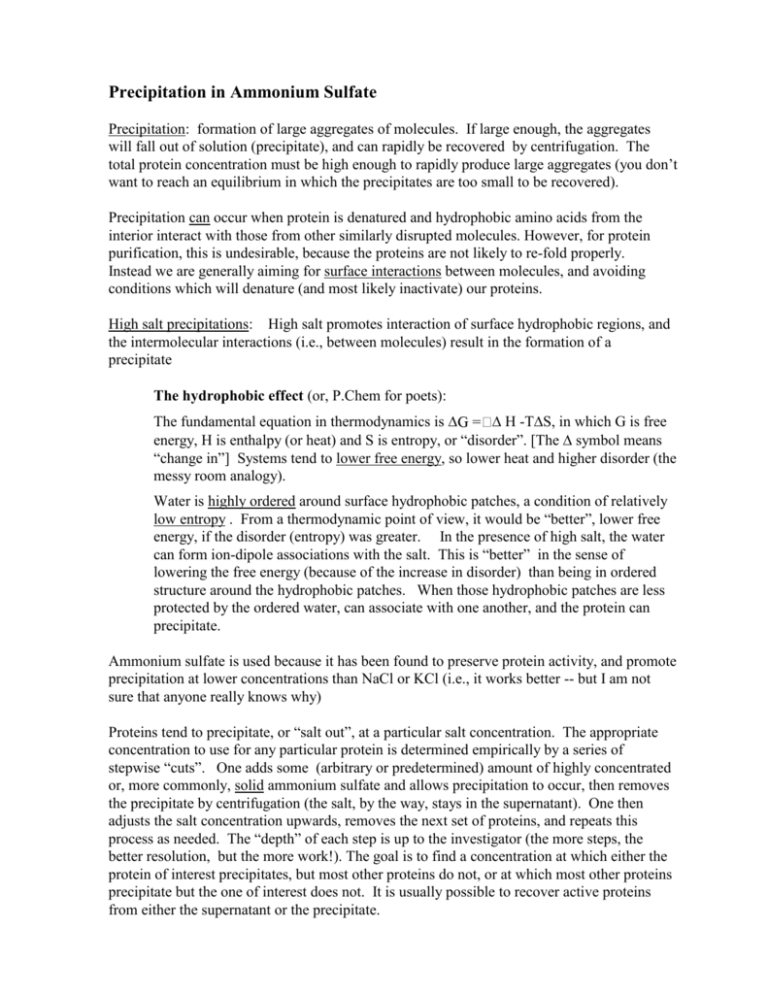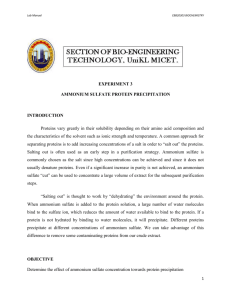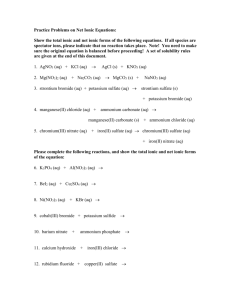Notes on Bulk Purification: Differential Precipitation
advertisement

Precipitation in Ammonium Sulfate Precipitation: formation of large aggregates of molecules. If large enough, the aggregates will fall out of solution (precipitate), and can rapidly be recovered by centrifugation. The total protein concentration must be high enough to rapidly produce large aggregates (you don’t want to reach an equilibrium in which the precipitates are too small to be recovered). Precipitation can occur when protein is denatured and hydrophobic amino acids from the interior interact with those from other similarly disrupted molecules. However, for protein purification, this is undesirable, because the proteins are not likely to re-fold properly. Instead we are generally aiming for surface interactions between molecules, and avoiding conditions which will denature (and most likely inactivate) our proteins. High salt precipitations: High salt promotes interaction of surface hydrophobic regions, and the intermolecular interactions (i.e., between molecules) result in the formation of a precipitate The hydrophobic effect (or, P.Chem for poets): The fundamental equation in thermodynamics is H -TS, in which G is free energy, H is enthalpy (or heat) and S is entropy, or “disorder”. [The symbol means “change in”] Systems tend to lower free energy, so lower heat and higher disorder (the messy room analogy). Water is highly ordered around surface hydrophobic patches, a condition of relatively low entropy . From a thermodynamic point of view, it would be “better”, lower free energy, if the disorder (entropy) was greater. In the presence of high salt, the water can form ion-dipole associations with the salt. This is “better” in the sense of lowering the free energy (because of the increase in disorder) than being in ordered structure around the hydrophobic patches. When those hydrophobic patches are less protected by the ordered water, can associate with one another, and the protein can precipitate. Ammonium sulfate is used because it has been found to preserve protein activity, and promote precipitation at lower concentrations than NaCl or KCl (i.e., it works better -- but I am not sure that anyone really knows why) Proteins tend to precipitate, or “salt out”, at a particular salt concentration. The appropriate concentration to use for any particular protein is determined empirically by a series of stepwise “cuts”. One adds some (arbitrary or predetermined) amount of highly concentrated or, more commonly, solid ammonium sulfate and allows precipitation to occur, then removes the precipitate by centrifugation (the salt, by the way, stays in the supernatant). One then adjusts the salt concentration upwards, removes the next set of proteins, and repeats this process as needed. The “depth” of each step is up to the investigator (the more steps, the better resolution, but the more work!). The goal is to find a concentration at which either the protein of interest precipitates, but most other proteins do not, or at which most other proteins precipitate but the one of interest does not. It is usually possible to recover active proteins from either the supernatant or the precipitate. This may be a good way to concentrate your protein (if it is in the precipitate, that fraction can be dissolved in a much smaller volume than the original). Alternatively, if your protein is in the supernatant of a high salt solution, you may be able to load it directly onto a hydrophobic column. (Often the interactions with the column will occur at lower salt concentrations than are required for precipitation, so your protein can be bound that way and then eluted with low salt). One thing you must learn that is different (and strange) with ammonium sulfate is that the concentration is often given as % saturation at 0 C, rather than % w/v, or molarity, or any other sensible thing. This is historical, but the convention persists. Its not all that bad, because it is generally possible to locate “The Table”, which gives the number of grams of ammonium sulfate one needs add in order to achieve a given % saturation, accounting for the change in volume effected by the added salt. It also tells you how to get from one % saturation to another. Look at the pink table: Starting with a salt-free solution, in order to achieve 20% saturation, we add 16.4 grams of solid ammonium sulfate per 100 ml of solution. Be aware that the final concentration is not 16.4% w/v, because that 16.4 g of ammonium sulfate also contributed volume, and the final solution will be greater than 100 mL. Now, lets say we spin out the precipitate, and want to take the supernatant to 50% saturation. We must determine the volume, and then add 17.5 g more ammonium sulfate per 100 ml of our 20% sup. It is worth noting that addition of solid ammonium sulfate can cause the pH to decrease. This will usually not affect the separation greatly, but can affect the proteins themselves. Another way of adjusting the salt concentration is by adding highly saturated solutions of ammonium sulfate, which can be buffered to avoid the pH changes. A saturated solution is made by warming water and adding ammonium sulfate until you cannot get any more to dissolve, and then cooling the solution to the point that some of the dissolved salt falls out. What is left will be saturated. This may or may not be practical, depending on how much you need to use, because it can increase the volume quite a bit. How do you figure out how much to add? It’s a C1V1, however, it is not as simple as you are used to. You are adding two volumes together, and the final volume will be the sum, but one of those volumes is the very thing you are solving for. Consider: How much of a 100% saturated solution does it take to bring 50 mL of sample to 60% saturation? X ml (100%) = (50 + X mL) 60%; since the units all match, we can ignore them, solving for X (the new volume) 100X = 60*50 + 60X 40X = 3000 X = 75 So you have to add 75 mL ,and your final volume will be 125 mL. That’s a big increase, which you may not want to deal with in a large prep. For other applications (small volumes that would be annoying to have to stir in the cold, fro example, adding saturated Amm Sulfate makes sense.







